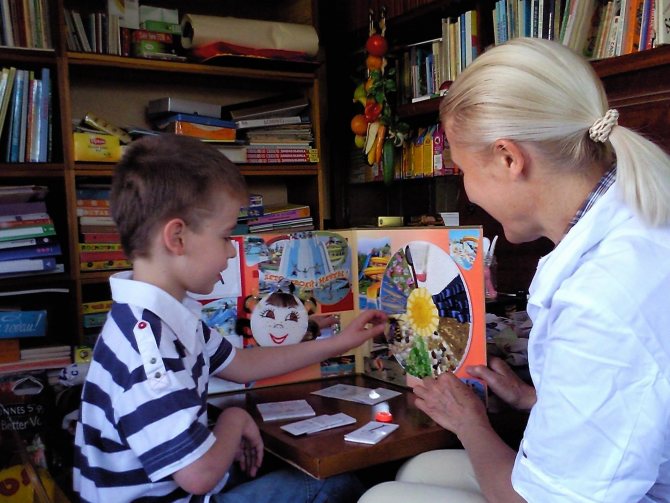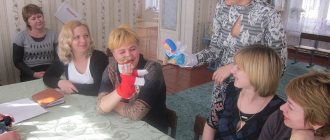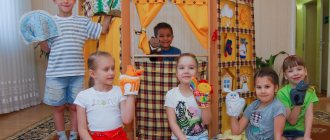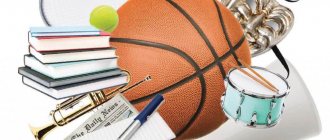Individual educational route work program in physical education (middle group)
Individual educational route
Full name of the child Tarkhanov Leonid Sergeevich
Date of birth: November 3, 2015
Mother's last name, middle name, age, education: Alexandrova Elena Veniaminovna
IOM start date: October 1, 2022
Reason for registration: The child makes mistakes in the basic elements of complex physical exercises. The greatest difficulties are identified when performing movements following verbal instructions. Difficulties appear when maintaining balance (general tension occurs, swaying of the body, balancing and getting out of place), jumping on 2 legs, jumping over, squats, bending, throwing and catching a ball. Low quality of movements is observed, violation of their order and quantity. Allows violation of rules in outdoor and sports games, most often due to insufficient physical fitness. Decreased interest in physical exercise. Low motor activity, reluctant to take part in outdoor games. The child is shy, difficult to play with peers, and lacks initiative.
Age at the beginning of correctional and developmental work: 3 years
Health group: II (ROP CNS)
Goal (IOM): Creation in kindergarten and family of conditions conducive to the child’s assimilation of an educational program on physical development, targeted advancement in development in accordance with their own capabilities.
Objectives: -to develop the child’s motor qualities: agility, speed, endurance, strength
— cultivate the need for physical improvement;
-promote the orientation of the pedagogical process towards the development of physical individual abilities.
-involve in systematic physical exercise and active participation in sports events at various levels.
Number of classes per week: 2 times a week, duration 15-20 minutes.
Expected result: gaining skills in performing basic movements, applying them in everyday life, showing interest in physical education classes, participating in outdoor and sports games with peers.
Long-term work plan for a physical education instructor
| month | Corrective tasks | Forms of work with the student | Forms of work with parents |
| October (I and II weeks) | Practice walking and running, coordinating the movements of your arms and legs. To help the child master the following skills: long jump through 4-6 sequential lines (with an energetic push and swing of the arms forward and up), climb up and down the gymnastic wall, walk on the bench, stepping over objects. | Walking: in a column, one at a time, on heels, on toes, performing imitative movements, with different positions of the hands (behind the head, to the sides, on the belt). Running: in a column, one at a time, running, throwing straight legs forward, stopping at a signal. Turns on the spot by jumping in different directions. Long jumps through 4-6 consecutive lines. Climbing: up and down the gymnastic wall. Balance: walking on a bench, stepping over blocks. Exercise "Sensory path". | Consultation: “Features of development of a 4-5 year old child” |
| October (III and IV weeks) | Help your child master the following skills: throw a ball at a vertical target; throw the ball on the floor and catch it; develop coordination of movements while handling the ball. | Walking: on toes (arms up), on heels (arms to the sides); side step with squat; gymnastic step. Running: “snake”, with an obstacle (checkmate), with the task of sitting down. Actions with the ball: throwing the ball up and catching it, throwing the ball on the floor and catching it, throwing the ball into the distance with hands thoughtfully from behind the head; throwing the ball into the distance with both hands from the chest; | |
| November (I and II weeks) | Practice jumping from a height of 20 cm; crawl on your stomach under a bench; step over cubes, ladder slats. Develop the ability to navigate in space. | Walking: on toes (game imitation exercise “Mice”), on heels, with small and wide steps, in a squat. Running: with diagonal acceleration, small and wide steps. Balance: stepping over cubes, slats (height 40 cm) Jumping: deep from a height of 20-30 cm Climbing: crawling on your stomach under a bench. Health exercise: “A strong wind is blowing” | Conversation: “The importance of physical exercise” Practical lesson: Manufacturing of non-standard equipment for physical education. |
| November (III and IV weeks) | Develop the ability to confidently and actively perform the basic elements of exercises. Help your child master the following skills: throw a ball at vertical and horizontal targets; jump on a hopper ball. | Walking: on toes (hands on the belt), on the outside of the foot, side step (hands on the belt), sideways with a squat. Running: wide and small strides, straight gallop, running with jumps on two legs, raising the knees high and moving forward. Actions with the ball: throwing the ball against the wall and catching it; throwing at a vertical target from a distance of 1.5 m (height 1.5 m); throwing at a horizontal target from a distance of 2 m; sit on a hopper ball and swing; jumping on a ball around the hall. Health exercise: “Hedgehog massage” | |
| December (I and II weeks) | Help your child master the following skills: jumping with a short rope; walk on a tightrope with an extended step; climb a gymnastic wall (with rhythmic ascent and descent) | Walking: on toes (arms up), on heels (arms to the sides), with small and wide steps; gymnastic step. Running: on high all fours straight, with an obstacle (mat - a vertically placed hoop mat). Balance: walking on a rope with an extended step; on an inclined board. Jumping: with a short rope Climbing: on a gymnastic wall (transition from flight to flight with an additional step) Health exercise: breathing training “Let’s blow on a snowflake” | Recommendations: “Outdoor games with parents on the weekend.” |
| December (III and IV weeks) | To help the child master the following skills: hit the ball on the spot with the right and left hands alternately; hit the ball with both hands while moving; throw the ball into the basket with both hands from the chest. Cultivate a desire to achieve certain results. | Walking: walking on the outside of the foot, with an extended step in a half-squat (hands on the belt), on the toes (arms to the sides, squeezing the fingers). Running: with the shin sweeping backwards, with the task of turning 360*, with a jump up. Actions with the ball: basketball player's stance (swing); throwing the ball on the floor and catching it; hitting the ball with both hands while simultaneously bouncing (“Balls”); hitting the ball alternately with the right and left hands (“Piano”); hitting the ball in any way while moving; throws into the basket with both hands from the chest; Health exercise: “Hedgehog massage” | |
| January (III and IV weeks) | Help your child master the following skills: roll a hoop to each other; throw the ball at a vertical target; throw the ball on the floor while moving and catch it; | Turns in place. Walking: on your heels (hands behind your head), on your toes (hands up “roof”), side step (hands on the belt), from one side to the other. Running: “snake”, with diagonal acceleration, with the task of squatting; straight gallop. Actions with a ball and a hoop: roll the hoop into the distance and run after it; roll a hoop to each other; throwing the ball up with both hands and catching it; throwing the ball down with both hands and catching it; throwing the ball from the chest into the distance; throwing the ball with both hands into the distance from behind the head. | Recommendations: “Joint sports activities between children and parents” Booklet: "Winter Fun" |
| February (I and II weeks) | Practice long jumps through 4-6 consecutive lines; strengthen the ability to crawl on a bench on all fours. Cultivate initiative when completing tasks. | Walking: in a column on the heels, on the toes (with different positions of the hands), performing imitative movements on a signal, rolling from heel to toe. Running: recreational, diagonal, with a change in direction of movement, side gallop (right, left shoulder forward). Balance: walking on a bench, placing your foot on your toes, arms to the sides. Jumps: long jumps sequentially through 4-6 lines; 4-6 cubes. Climbing: crawling on a bench on all fours. Breathing exercises: “Lumberjack”, “Whistle”, | Consultation: “Development of physical qualities in games and game exercises.” Toy library for parents: "Outdoor Games" |
| February (III and IV weeks) | Help your child master the following skills: jump on a ball-hopper “snake” between objects; throw at horizontal (distance 2 m) and vertical targets. Develop eye, flexibility, dexterity. Develop the ability to help clean equipment at the request of an adult. | Walking: in a column on the heels, on the toes (with different positions of the hands), performing imitative movements on a signal. Running: with a change of direction, small and wide steps, with a task - a 360 * turn, with an obstacle (from hoop to hoop, which lie on the floor). Actions with the ball: sit on the hopper ball - swing, jump on the hopper ball throughout the space; jumping on a ball “snake” between objects; throwing at a vertical target from a distance of 1.5 -2 m, throwing at a horizontal target from a distance of 2 m. Breathing exercise “Blow away a snowflake.” | |
| March (I and II weeks) | Practice balance, jumping on two legs and moving forward; consolidate the ability to climb a gymnastic wall with an additional and alternating step, climb straight and sideways into a hoop. | Walking: changing direction of movement, on your toes, on your heels, in a half squat. Running: with acceleration diagonally, side gallop with an obstacle (on the board, between objects). Balance: stepping over the slats of a ladder placed on objects 30 cm high. Jumping: on two legs moving forward (from hoop to hoop, through circles) Climbing: climbing straight and sideways into a hoop (the hoop is raised above the floor to a height of 10cm); climbing a gymnastic wall up and down with added and alternating steps to a height of 1.2 m. Exercise "Heron" Exercise "Mirror" | Recommendations: "Physical training". Visual information: "Sports corner at home" |
| March (III and IV weeks) | To help the child master the skills to act with the ball: throwing it on the floor and catching it; hit the ball with one or two hands while standing still; hit the ball in any way while moving; throw the ball into the basket with both hands from the chest. | Walking: walking in a snake between objects, on the toes (arms to the sides), on the outside of the foot, on the heels (hands behind the back), side step. Running: straight gallop, running with an obstacle (board), with the shin sweeping backwards. Actions with the ball: throwing the ball up and catching it with both hands; throwing the ball with one hand on the floor, catching with both hands; throwing a bag (tennis ball) into the distance alternately with the right and then with the left hand, throwing the ball into the basket with both hands using the chest method; hitting the ball in any way in motion. | |
System for monitoring the achievement of planned results.
Monitoring of child development will be carried out in March. The main task of monitoring is to determine the degree to which a child has mastered the educational program and the impact of the educational process organized in a preschool institution on the child’s development.
| Directions of development | Diagnostic techniques |
| Physical development | Program "Childhood" ed. Babaeva T.I., Gogoberidze A.G., Solntseva O.V. |
| Tarasova T.A. Monitoring the physical condition of preschool children Prishchepa S., Popkova N., Konyakhina T. How to diagnose the physical fitness of a preschooler |
| № | Test name | Detected qualities |
| 1 | 30 m run from the start | speed, reaction speed |
| 2 | standing long jump | speed - strength qualities |
| 3 | throwing a medicine ball weighing 1 kg into the distance with both hands from behind the head from starting position standing | indicative reactions and coordination abilities |
| 4 | bending the torso forward from a standing position | flexibility |
| 5 | throwing a bag of sand into the distance with the right and left hand (bag weight: 150 g for children 4 years old and 200 g for children 5-7 years old) | coordination abilities |
Determining the level of speed formation
30 meter dash
A straight asphalt or tightly compacted path, 2-3 m wide and at least 40 m long, is selected. The start line and the finish line are marked on the path. A bright landmark is installed at a distance of 3 m from the finish line so that children do not slow down long before the finish line.
Equipment. Stopwatch, flag.
Quantitative indicator: running time (in minutes)
Tests to determine speed and strength qualities
Standing long jump
A mat or rubber track is placed in the hall, and markings are applied to the side.
The child jumps, pushing off with both legs, with an intense swing of his arms, from the marked take-off line to the maximum distance for him and lands on both legs. When landing, do not lean behind with your hands. The distance between the take-off line and the footprint (at the heels) when landing is measured (in cm). The best attempt is counted.
Necessary equipment: tape measure, chalk, mat or rubberized track. The test is intended for children from 3 to 7 years old.
Quantitative indicator: jump length (in cm)
Throwing a medicine ball (1 kg) with both hands from behind the head from a standing starting position
The test is carried out on a flat area at least 10 m long. The child stands at the control marking line and throws the ball from behind the head with both hands forward from the starting position standing, one leg in front, the other behind, or legs apart. When throwing, your feet must remain in contact with the ground. Movement following the thrown is allowed. 3 attempts are made. The best result is counted.
The test is intended for children from 3 to 7 years old.
Required equipment: (medical) medicine ball weighing 1 kg, marked area for pushing the ball.
Quantitative indicator: throw range (in cm)
Throwing a light ball at a distance
The throwing range survey is carried out on an asphalt track or physical training ground. The throwing corridor must be at least 3 m wide and 15-20 m long. The track is preliminarily marked with chalk with transverse lines every meter and the distance is numbered with numbers. At the teacher’s command, the child approaches the take-off line, from a standing starting position, throws the ball with one hand from behind the head, one leg is placed in front of the other at a step distance. When throwing, you cannot change the position of your feet. The best result out of 3 attempts is counted.
The test is intended for children from 3 to 7 years old.
Necessary equipment: light ball or bags of sand weighing up to 200 g in an amount of at least 3, tape measure 20 m long, chalk, marked path.
Quantitative indicator: throw range (in cm)
Bend the torso forward from a standing position
Flexibility is assessed using an exercise - bending forward while standing on a gymnastic bench or other object with a height of at least 20-25 cm. To measure the depth of the bend, a ruler or bar is attached so that the zero mark corresponds to the level of the support plane. If the child does not reach the zero mark with his fingertips, then the result is determined with a minus sign. When performing the exercise, your knees should not bend.
IOM tasks, review and approval procedure
Individual educational routes are designed:
- for problem children who experience difficulties in the process of mastering the general education program for preschoolers and need correctional assistance from specialists;
- for pupils with disabilities, disabled children;
- for gifted children with a level of ability exceeding average regulatory educational standards.
The purpose of the individual educational route is to solve the problem of accessibility of preschool institutions for children with disabilities
Leading tasks of an individual educational route:
- provide support and assistance in self-development and mastering the preschool education program;
- to form in the child an initial level of learning ability, i.e. teach him to understand the educational task, plan his educational activities, concentrate on completing the exercise, develop self-discipline and volitional qualities;
- develop and improve movement coordination skills, development of gross and fine motor skills;
- to form and consolidate general cultural, everyday, hygienic, communicative foundations of behavior;
- to accustom the child to manipulative-objective, sensory, practical, play activities, to develop skills in the productive area (drawing, modeling, appliqué);
- develop speech - emotional intonation, grammatical structures, speech mechanisms;
- to generate knowledge about the natural environment and the world of social relations;
- form ideas about spatio-temporal and quantitative categories.
Methodological tools that are used in the passage of an individual development trajectory:
- role-playing and outdoor games, classes in the form of conversation and dialogue, reading and discussion of literary works, small improvisation sketches that enhance the emotional component of information perception;
- psychological trainings and game exercises that help relaxation, neutralize fears, reduce anxiety and aggression, improve behavioral sphere, as well as social and communication skills;
- exercises to develop thinking, imagination, speech, memory;
- use of art therapy techniques (treatment with art, fairy tales, doll making).

Individual attitude and an integrated approach to the problem of development are the key to success even in the most difficult situation!
Development and adoption of the IOM
To create an individual educational route, it is first necessary to conduct a diagnostic study to find out the level of psycho-emotional, intellectual, communicative, social and physical development of the child. The diagnostic results are presented to the teachers' council, which subsequently recommends that the children be examined by specialists from the PMPK (psychological, medical and pedagogical council).
Sample for the conclusion and recommendations of the PMPC
| FULL NAME. child |
| Date of Birth |
| Family information: Mother (full name, education, place of work) |
| Father (full name, education, place of work) |
| Teachers (full name): |
| Specialists: Speech therapist teacher: Speech pathologist teacher: Educational psychologist: Music director: Senior nurse: |
| Health group |
| Regime of a child’s stay in a preschool educational institution |
| Conclusion of the PMPC |
| PMPC recommendations |
| Long term goals |
| Goals for the current period (academic year) |
The council compiles a list of children for whom the development of an individual educational work plan is relevant.
Individual route for a gifted child for physical development
Individual map and route support for a preschool child with signs of giftedness.
Explanatory note
Preschool age is the most favorable period for the beginning of the development of abilities. It is necessary to understand that a child develops only those abilities for which there are incentives and conditions. Creating favorable conditions is necessary for the development of everyone’s individuality. In this regard, the problem of a teacher’s understanding of his students and an individual approach to each of them acquires special significance. Among the striking individual differences of a child are ability and giftedness. As a rule, abilities are understood as the characteristics of a child that ensure high achievements in a specific type of activity. Giftedness is interpreted as a qualitative, unique combination of abilities that ensures the success of performing actions.
In this regard, our preschool educational institution has developed the “YOUNG TALENTS” program, the goal of which is to create and implement a model for identifying and developing the inclinations and abilities of success of each child in the educational process.
The program “YOUNG TALENTS” of a physical education and sports orientation is compiled on the basis of the “Basic general education program “SOTSVETIE” - MKDOU “TsRR - kindergarten No. 3”, taking into account the approximate general education program “From birth to school” edited by N.E. Veraksy, T.S. Komarova, M.A. Vasilyeva.
The program is aimed at maximizing the potential of children, improving the system for identifying gifted children from middle preschool age, providing support to each child, developing individual development cards taking into account the physiological and individual abilities and giftedness of the child.
The program is a harmonious, flexible system that will teach a child to feel and control his body, receiving pleasure and joy from it. The program provides for protecting the life and strengthening the health of the child, maintaining a cheerful, cheerful mood, preventing negative emotions, nurturing positive moral and volitional qualities, and developing creative potential.
1.Target section
Last name, first name, date of birth - Stepanova Yesenia - 5 years old.
Preschool educational institution - MKDOU "TsRR - kindergarten No. 3"
General information about the child
Yesenia is a girl with pronounced athletic abilities.
Very flexible and flexible, has innate flexibility, loves music, is artistic, quickly grasps everything new, has endurance, and shows willpower. Preserving and developing the sports potential of each child seems to be a very important and urgent task, therefore an individual educational route was drawn up to work with Yesenia.
The purpose and objectives of educational activities
Goal: creating optimal conditions for the development and implementation of the child’s sports and creative abilities, taking into account his age and individual characteristics.
Tasks:
- reveal athletic abilities;
improve and expand the system of additional education;
— involve in competitions at various levels;
— create a rich subject-developing sports environment




